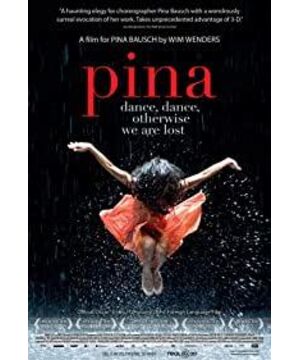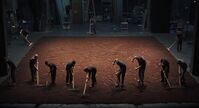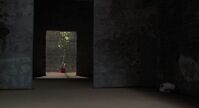"Pina" is a movie that belongs to the dead. Therefore, whether it is the wonderful reproduction of the dancers in the video, or the touching recollection of the language piercing the expressions, this intellectual film casts a huge emotional shadow. In this sense, Wenders' utterly dishonest behavior—an almost mythical writing about Pina—is naturally forgiven, even forgotten, by sentimentality.
The intelligence of the film comes from the noble gesture of Pina, a dancer, who is deeply immersed in the palace of thought. In Pina's design, dance is no longer a simple and superficial object of enjoyment, but a complex language floating between spoken objects and metaphorical poems. It can either be a part of the peaceful world within nature, or it can manifest itself as a living being that bursts out with great tragic power. Wenders microscopically magnifies and reproduces these modes of speech in the film. And behind these twisting bodies, Pina showed a huge figure and continued to meditate. It seems to this German that any expression that does not reach the depths of the soul is unworthy of existence, whether it has its origins in morals or aesthetics.
At the beginning of the film, time appears. It puts on a meaningful smile in the simple repetition of body symbolism. Repetition is an important force in Pina's body art that cannot be overlooked. In the group dance "Rite of Spring" that fell on the dust, the men and women threw out their hard emotions in the repeated swings of their bodies, and in the end, it had nothing to do with elegance, and the almost savage struggle was repeated again and again. The cowardly glances reached their climax. Wittgenstein once said in his critique of classical music that repetition is necessary because only repetition can bring out the amazing power of certain themes. In the film's rendition of Pina's dance art, repetition is almost everywhere: we see a repeated fall on the steps, a repeated drop in Café Mueller, a character repeated in a scene appearance, or even repeated aggression under a certain emotion. It's these high notes that are constantly being played that make something stand out. Wenders is clearly aware of the importance of repetition in all kinds of art. He made the pleasant but mysterious time symbols of spring, summer, autumn and winter appear repeatedly at the beginning and end, and seemed to have successfully drowned out part of the sadness of death with the flowing time.
In Café Mueller, one of Pina's most acclaimed works, the drive to speak almost transcends the act of theatricality into a mere act of dance, conveying an absurdity akin to Beckett's. Pina's presence forms the ongoing backdrop in which the play takes place. She swayed almost out of control in a small space, immersed in the pain in her heart, as if trapped in a transparent prison. And under the shroud of this emotion, our eyes met the lovers. They were excited to find each other and hugged tightly. But the hand of fate appeared. Powerful and powerful, he manipulated them time and time again, choosing for them a posture that seemed unequal. They fought, plucked up their courage, and found their way. But in the end they seemed lost. An inexorable tension tormented them. Pain became a huge unspoken language roaring in that space. In the end, they start hurting each other, and as darkness comes, the love doesn't go away.
In this work, Pina seems to recreate Sartre's existential allegory in a slightly less dramatic way. But throughout, the chaotic and powerful dance gives the video an aesthetic punch. And aesthetics is so deeply embedded in morality. Those choreographed beats, spasms, struggles, and anxieties produced a contagion that no intellectual philosophy could match. We seem to see the hellish nature of modern life, the rifts that cannot be healed, and even the original sin of humanity.
As a great female artist, Pina did not miss making her voice heard in the wave of feminism, although she did not observe anything special. Women remain a sought-after object of desire in the world Pina struggles to speak of. At fifty and sixty minutes into the film, Pina performs two different physical experiments. The madness of the former seems to announce an unstoppable primordial force. Under the shroud of this force, women lean against the wall and can only respond or escape awkwardly; while the latter's calm play and the complete objectification of women have turned the relationship between the two sexes. Combined with naked buying behavior. In both metaphorical acts, the action acts as a force similar to the essence of the body: using the language of the body to express its own desires, especially the complexities of desires. Maybe Pina didn't discover anything new, but she seemed to know exactly what was important. It takes just as much effort to tell something important in a new, impressive, and even soul-like way.
What Wenders is trying to do in this film is to show the richness of body language and the proximity of the body to the soul. This is Pina's sincere gesture as a dancer, and a soul-wrenching and profound confession. Facing her death, Wenders offered his best offering.
View more about Pina reviews







